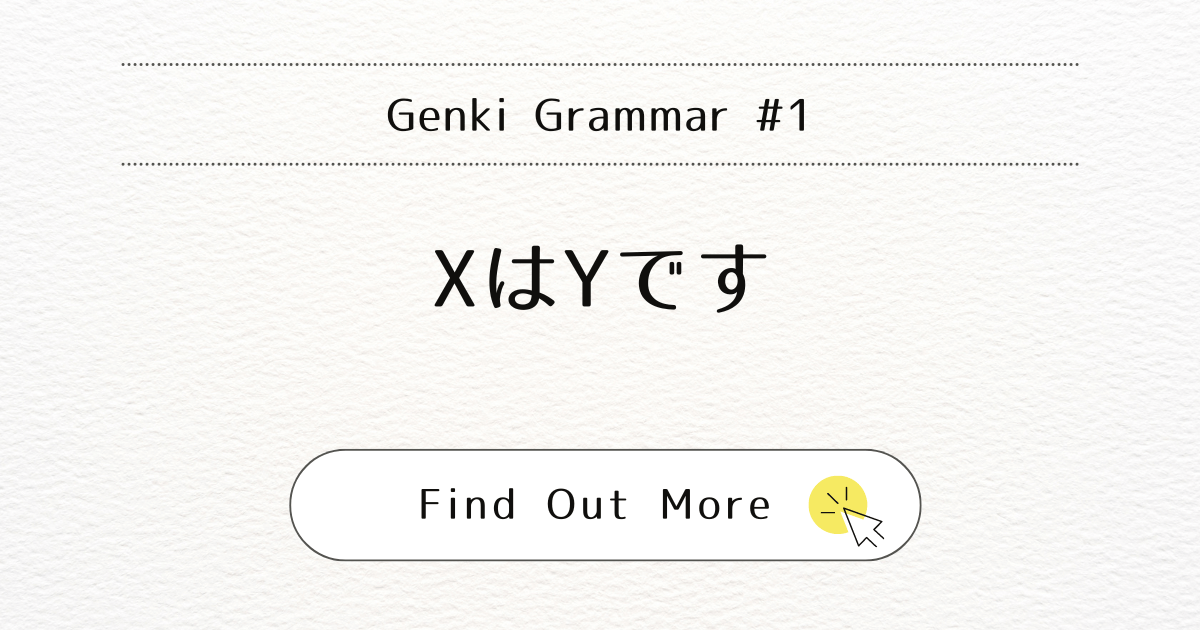Introduction
Welcome to our series on Genki grammar. Today, we’re looking at a very important pattern: “XはYです”. This pattern is a building block for forming basic sentences in Japanese.
What it means
“XはYです” connects two parts of a sentence: X (the topic you’re talking about) and Y (what you’re saying about X). It’s like saying “About X, it is Y.”
When You Use It
You can use “XはYです” in many situations:
- Introducing yourself.
- Talking about your major or hobbies.
- Describing things around you.
Looking at Examples
“私は学生です” (Watashi wa gakusei desu) – “I am a student.”
“私の専攻は日本語です” (Watashi no senkoo wa nihongo desu) – “My major is is Japanese.”
These show how you can use “XはYです” to talk about yourself or things related to you.
How ‘は’ (wa) Works
In these sentences, ‘は’ (said as ‘wa’) acts like a spotlight, focusing on the topic. It’s not just about who or what does something, but what we’re specifically talking about.
Words that fit into the X and Y
In the table below, we list examples of words that can be used in the positions of X and Y in the sentence pattern “XはYです”. Words marked with a ○ are appropriate for this structure.
| X | は | Y | です |
| Topic (subject) | Particle (topic marker) | Noun | Copula |
| わたし | は | がくせい | です |
| Common noun | Common noun | ||
| Proper noun | Proper noun | ||
| Demonstrative/ Pronoun | Demonstrative/ Pronoun |
Common Noun:
These are basic names for people, places, or things. They’re not capitalized unless they’re at the start of a sentence.
Example: “犬” (inu) means ‘dog’. It’s a common noun for any dog.
Proper Noun:
These are names for specific people, places, or things and they always have a capital letter.
Example: “東京” (Tokyo) is a proper noun; it’s the name of a city in Japan.
Demonstrative:
These words point out specific nouns, like ‘this’ or ‘that’.
Example: “この犬” (kono inu) means ‘this dog’. “この” (kono) is the demonstrative for ‘this’.
Pronoun:
Pronouns are used in place of nouns to avoid repeating them.
Example: “彼女” (kanojo) stands for ‘she’ or ‘her’, replacing the name of a woman or female noun.
It’s important to note that while the table shows single nouns for simplicity, you can also use noun phrases (groups of words that act as a noun). For example, the phrase わたしのせんこう (my major) can be used as X in the sentence “私の専攻は日本語です” (My major is Japanese).
Note
- Leaving Out Subjects
In Japanese, you often don’t have to say the subject if it’s clear from the context. For example, if someone asks about your job, you can just say “学生です” (Gakusei desu) – “A student.” - Pronouncing ‘は’
Remember, ‘は’ is usually said as ‘ha’, but in this pattern, you say it as ‘wa’. This is an important point for speaking Japanese correctly. - Handling Nouns
Japanese doesn’t use different forms for singular and plural nouns and doesn’t use articles like “a” or “the”. This makes using nouns simpler.
English: “Dog” and “dogs”
Japanese: 犬 (いぬ, Inu).
Conclusion
The “XはYです” structure is essential for anyone learning Japanese. It’s a great starting point for making your own sentences and getting comfortable with the language.



